Causal Analysis of Safety Risk Perception of Iranian Coal Mining Workers Using Fuzzy Delphi and DEMATEL
Abstract
1. Introduction
2. Literature Review
Problem Statement and Study Contributions
- Based on the research conducted, this study is one of the first to investigate the factors affecting the risk perception of underground coal mine workers, evaluate their interdependencies, and provide valuable insight into understanding the root causes of human error and unsafe behavior in underground coal mines.
- In addition, providing control solutions helps managers, experts, and legal organizations understand the underlying factors of accidents and unfortunate events and improve underground mines’ safety management systems.
3. Materials and Methods
3.1. Extraction of Influential Factors on Risk Perception
3.2. Classification of Variables with the Fuzzy Delphi Method
3.2.1. The Fuzzy Delphi Method
3.2.2. Setting the Expert’s Panel
3.2.3. Conducting Rounds 1 and 2 of the Fuzzy Delphi Study
3.2.4. Ranking of Variables
3.3. Determining the Cause-and-Effect Relationships of the Variables
3.3.1. DEMATEL Method
- First step: forming a group of experts to collect their group knowledge about the relationship of variables. In this study, ten experts in the field of safety and hygiene of coal mines and risk perception participated in the study as an expert group. Individuals were invited and agreed to participate in the study through official correspondence.
- Second step: determining the variables to be evaluated. In the first stage, the desired variables were determined through the fuzzy Delphi method, and a total of 23 variables were selected as the most important variables affecting risk perception from each of the sub-groups of external, organizational, task, environmental, and individual variables.
- Third step: designing a questionnaire and forming a couple relationship matrix. The questionnaire was formed in the form of a 24 × 24 square matrix so that the experts could determine the relationship between the variables in pairs in the form of verbal expressions.
- Fourth step: analyzing the results based on the DEMATEL method. This analysis is described in Section 3.3.1.
3.3.2. Forming the Matrix of Direct Relationships
- After obtaining the experts’ opinions, the average matrix was generated (M). Likert scales ranging from 0 to 4 were employed, with the response choices indicating “no influence”, “little influence”, “medium influence”, “strong influence”, and “very strong influence”. In the next step, the overall average impact value was determined for all respondents (Table A1).
- Calculating the normalized direct-relation matrix (M’):
- Calculate total-relation matrix (T) based on Equation (4):
- The values of R are obtained based on the components of the matrix of the total relationship for each variable based on Equations (5) and (6):where:tij = total (direct and indirect) influence from indicator i to indicator j, andn = the number of indicators.
- The values of J + R and J − R were calculated, and the cause-and-effect relationships between the variables were drawn. The value of J + R is placed on the x-axis and J − R on the y-axis.
4. Results
4.1. Ranking Variables Affecting Risk Perception
4.2. Determining the Cause-and-Effect Relationships among Variables Affecting RP
5. Discussion
6. Conclusions
Author Contributions
Funding
Institutional Review Board Statement
Informed Consent Statement
Data Availability Statement
Conflicts of Interest
Appendix A
| SLO | ST | SM | SC | ATE | …… | PPE | RA | PH | JS | RP | |
|---|---|---|---|---|---|---|---|---|---|---|---|
| 0 | 3 | 2 | 3 | 3 | ........ | 3 | 3 | 0 | 2 | 1 | SLO |
| 0 | 0 | 2 | 4 | 3 | ......... | 4 | 4 | 0 | 2 | 4 | ST |
| 2 | 4 | 0 | 4 | 4 | ........ | 4 | 3 | 3 | 4 | 4 | SM |
| 3 | 4 | 4 | 0 | 4 | ........ | 4 | 4 | 1 | 4 | 4 | SC |
| 0 | 3 | 0 | 4 | 0 | ........ | 4 | 4 | 3 | 4 | 4 | ATE |
| ⁞ | ⁞ | ⁞ | ⁞ | ⁞ | 0 | ⁞ | ⁞ | ⁞ | ⁞ | ⁞ | ⁞ |
| 0 | 1 | 0 | 1 | 0 | ....... | 0 | 2 | 3 | 4 | 1 | PPE |
| 0 | 0 | 0 | 0 | 0 | ...... | 3 | 0 | 0 | 0 | 1 | RA |
| 0 | 0 | 0 | 3 | 0 | ....... | 3 | 4 | 0 | 3 | 4 | PH |
| 0 | 0 | 0 | 3 | 0 | ....... | 3 | 3 | 3 | 0 | 3 | JS |
| 0 | 0 | 3 | 3 | 2 | ....... | 3 | 4 | 0 | 0 | 0 | RP |
| SLO | ST | SM | SC | ATE | …… | PPE | RA | PH | JS | RP | M |
|---|---|---|---|---|---|---|---|---|---|---|---|
| 0 | 0.038 | 0.025 | 0.038 | 0.038 | ........ | 0.038 | 0.038 | 0 | 0.025 | 0.012 | SLO |
| 0 | 0 | 0.025 | 0.051 | 0.038 | ......... | 0.051 | 0.051 | 0 | 0.025 | 0.051 | ST |
| 0.025 | 0.051 | 0 | 0.051 | 0.051 | ........ | 0.051 | 0.038 | 0.038 | 0.051 | 0.051 | SM |
| 0.038 | 0.051 | 0.051 | 0 | 0.051 | ........ | 0.051 | 0.051 | 0.012 | 0.051 | 0.051 | SC |
| 0 | 0.038 | 0 | 0.051 | 0 | ........ | 0.051 | 0.051 | 0.038 | 0.051 | 0.051 | ATE |
| ⁞ | ⁞ | ⁞ | ⁞ | ⁞ | 0 | ⁞ | ⁞ | ⁞ | ⁞ | ⁞ | ⁞ |
| 0 | 0.012 | 0 | 0.012 | 0 | ....... | 0 | 0.025 | 0.038 | 0.025 | 0.012 | PPE |
| 0 | 0 | 0 | 0 | 0 | ...... | 0.038 | 0 | 0 | 0 | 0.012 | RA |
| 0 | 0 | 0 | 0.038 | 0 | ....... | 0.038 | 0.051 | 0 | 0.038 | 0.051 | PH |
| 0 | 0 | 0 | 0.038 | 0 | ....... | 0.038 | 0.038 | 0.038 | 0 | 0.038 | JS |
| 0 | 0 | 0.038 | 0.038 | 0.025 | ....... | 0.038 | 0.051 | 0 | 0 | 0 | RP |
| SLO | ST | SM | SC | ATE | …… | PPE | RA | PH | JS | RP | |
|---|---|---|---|---|---|---|---|---|---|---|---|
| 0.007 | 0.065 | 0.039 | 0.074 | 0.056 | ........ | 0.084 | 0.087 | 0.029 | 0.059 | 0.062 | SLO |
| 0.008 | 0.034 | 0.035 | 0.096 | 0.061 | ......... | 0.0108 | 0.114 | 0.034 | 0.066 | 0.110 | ST |
| 0.036 | 0.093 | 0.025 | 0.114 | 0.081 | ........ | 0.130 | 0.125 | 0.087 | 0.108 | 0.134 | SM |
| 0.049 | 0.099 | 0.076 | 0.070 | 0.085 | ........ | 0.136 | 0.143 | 0.067 | 0.112 | 0.140 | SC |
| 0.009 | 0.075 | 0.022 | 0.106 | 0.027 | ........ | 0.125 | 0.128 | 0.088 | 0.114 | 0.129 | ATE |
| ⁞ | ⁞ | ⁞ | ⁞ | ⁞ | 0 | ⁞ | ⁞ | ⁞ | ⁞ | ⁞ | ⁞ |
| 0.002 | 0.02 | 0.005 | 0.027 | 0.006 | ....... | 0.018 | 0.044 | 0.048 | 0.037 | 0.031 | PPE |
| 0.003 | 0.021 | 0.006 | 0.015 | 0.008 | ...... | 0.056 | 0.021 | 0.012 | 0.012 | 0.032 | RA |
| 0.006 | 0.023 | 0.015 | 0.073 | 0.018 | ....... | 0.083 | 0.100 | 0.029 | 0.071 | 0.096 | PH |
| 0.006 | 0.025 | 0.015 | 0.084 | 0.017 | ....... | 0.083 | 0.09 | 0.066 | 0.033 | 0.086 | JS |
| 0.008 | 0.026 | 0.050 | 0.068 | 0.042 | ....... | 0.076 | 0.091 | 0.022 | 0.025 | 0.039 | RP |
References
- Qiu, Z.; Liu, Q.; Li, X.; Zhang, J.; Zhang, Y. Construction and analysis of a coal mine accident causation network based on text mining. Process Saf. Environ. Prot. 2021, 153, 320–328. [Google Scholar] [CrossRef]
- Bakhtavar, E.; Shahmoradi, M.; Rahmati, S. Evaluation of the impacts of challenging factors on underground colliery occupational hazards in Iran using fuzzy cause and effect interaction. J. Min. Eng. 2018, 13, 34–45. [Google Scholar]
- Zhao, L.; Jin-an, W. Accident investigation of mine subsidence with application of particle flow code. Procedia Eng. 2011, 26, 1698–1704. [Google Scholar] [CrossRef][Green Version]
- Lama, R.; Bodziony, J. Management of outburst in underground coal mines. Int. J. Coal Geol. 1998, 35, 83–115. [Google Scholar] [CrossRef]
- Onder, M.; Onder, S.; Adiguzel, E. Applying hierarchical loglinear models to nonfatal underground coal mine accidents for safety management. Int. J. Occup. Saf. Ergon. 2014, 20, 239–248. [Google Scholar] [CrossRef]
- Saleh, J.H.; Cummings, A.M. Safety in the mining industry and the unfinished legacy of mining accidents: Safety levers and defense-in-depth for addressing mining hazards. Saf. Sci. 2011, 49, 764–777. [Google Scholar] [CrossRef]
- Khanzode, V.V.; Maiti, J.; Ray, P. A methodology for evaluation and monitoring of recurring hazards in underground coal mining. Saf. Sci. 2011, 49, 1172–1179. [Google Scholar] [CrossRef]
- Maiti, J.; Khanzode, V.V. Development of a relative risk model for roof and side fall fatal accidents in underground coal mines in India. Saf. Sci. 2009, 47, 1068–1076. [Google Scholar] [CrossRef]
- Stojadinović, S.; Svrkota, I.; Petrović, D.; Denić, M.; Pantović, R.; Milić, V. Mining injuries in Serbian underground coal mines–A 10-year study. Injury 2012, 43, 2001–2005. [Google Scholar] [CrossRef]
- Leigh, J.P.; Waehrer, G.; Miller, T.R.; Keenan, C. Costs of occupational injury and illness across industries. Scand. J. Work Environ. Health 2004, 30, 199–205. [Google Scholar] [CrossRef]
- Liu, Q.; Li, X.; Meng, X. Effectiveness research on the multi-player evolutionary game of coal-mine safety regulation in China based on system dynamics. Saf. Sci. 2019, 111, 224–233. [Google Scholar] [CrossRef]
- Lawrence, A. Human error as a cause of accidents in gold mining. J. Saf. Res. 1974, 6, 78–88. [Google Scholar]
- Kumar, P.; Gupta, S.; Gunda, Y.R. Estimation of human error rate in underground coal mines through retrospective analysis of mining accident reports and some error reduction strategies. Saf. Sci. 2020, 123, 104555. [Google Scholar] [CrossRef]
- Simpson, G.; Horberry, T. Understanding Human Error in Mine Safety; CRC Press: Boca Raton, FL, USA, 2018. [Google Scholar]
- Wang, L.; Wang, Y.; Cao, Q.; Li, X.; Li, J.; Wu, X. A framework for human error risk analysis of coal mine emergency evacuation in China. J. Loss Prev. Process Ind. 2014, 30, 113–123. [Google Scholar] [CrossRef]
- Patterson, J. Human Error in Mining: A Multivariable Analysis of Mining Accidents/Incidents in Queensland, Australia and the United States of America Using the Human Factors Analysis and Classification System Framework. Ph.D. Thesis, Clemson University, Clemson, SC, USA, 2009. [Google Scholar]
- Geng, F.; Saleh, J.H. Challenging the emerging narrative: Critical examination of coalmining safety in China, and recommendations for tackling mining hazards. Saf. Sci. 2015, 75, 36–48. [Google Scholar] [CrossRef]
- Patterson, J.M.; Shappell, S.A. Operator error and system deficiencies: Analysis of 508 mining incidents and accidents from Queensland, Australia using HFACS. Accid. Anal. Prev. 2010, 42, 1379–1385. [Google Scholar] [CrossRef] [PubMed]
- Mohammadfam, I.; Khajevandi, A.A.; Dehghani, H.; Babamiri, M.; Farhadian, M. Analysis of factors affecting human reliability in the mining process design using Fuzzy Delphi and DEMATEL methods. Sustainability 2022, 14, 8168. [Google Scholar] [CrossRef]
- Gordon, R.P. The contribution of human factors to accidents in the offshore oil industry. Reliab. Eng. Syst. Saf. 1998, 61, 95–108. [Google Scholar] [CrossRef]
- Rundmo, T. Associations between risk perception and safety. Occup. Health Ind. Med. 1997, 2, 53. [Google Scholar] [CrossRef]
- Jafari, M.; Kouhi, F.; Movahedi, M.; Allah-Yari, T. The effect of job safety analysis on risk perception of workers at high risk jobs in a refinery. Iran Occup. Health 2010, 6, 12–25. [Google Scholar]
- Sjöberg, L.; Moen, B.-E.; Rundmo, T. Explaining risk perception. An evaluation of the psychometric paradigm in risk perception research. Rotunde Publ. Rotunde 2004, 84, 55–76. [Google Scholar]
- Hughes, P.W.; Ferrett, E. Introduction to Health and Safety in Construction; Elsevier Butterworth-Heinemann: Oxford, UK, 2005. [Google Scholar]
- Chen, L.; Li, H.; Tian, S. Application of AHP and DEMATEL for identifying factors influencing coal mine practitioners’ unsafe state. Sustainability 2022, 14, 14511. [Google Scholar] [CrossRef]
- Ghiami, M.; Vaziri, M.H.; Gholamnia, R.; Saeedi, R.; Motalebi, M. Investigating the relationship between risk perception, resources and rate of job stress with occupational accidents in a steel industry. Iran AQ5 Occup. Health 2020, 17, 1109–1121. [Google Scholar]
- Yeganeh, R.; Mohammadfam, I.; Soltanian, A.; Mirzaei Aliabadi, M. An integrative fuzzy Delphi decision-making trial and evaluation laboratory (DEMATEL) study on the risk perception-influencing factors. Int. J. Occup. Saf. Ergon. 2023, 29, 1135–1146. [Google Scholar] [CrossRef] [PubMed]
- Ding, Y.; Du, X.; Li, Q.; Zhang, M.; Zhang, Q.; Tan, X.; Liu, Q. Risk perception of coronavirus disease 2019 (COVID-19) and its related factors among college students in China during quarantine. PLoS ONE 2020, 15, e0237626. [Google Scholar] [CrossRef] [PubMed]
- Pandit, B.; Albert, A.; Patil, Y.; Al-Bayati, A.J. Impact of safety climate on hazard recognition and safety risk perception. Saf. Sci. 2019, 113, 44–53. [Google Scholar] [CrossRef]
- Khajavi, S.; Ebrahimi Ghavam Abadi, L. Study of relationship between occupational accidents risk perception of gas stations workers in Ahvaz City with the HSE management performance in fueling stations in 2016. Iran Occup. Health 2018, 15, 34–46. [Google Scholar]
- Asivandzadeh, E.; Jamalizadeh, Z.; Safari Variani, A.; Mohebi, A.; Khoshnavaz, H. Evaluating the Impact of Training and Technical Interventions on Improving Safety Culture and Understanding the Risk of Dangerous Situations at Height among Construction Workers. J. Health 2020, 11, 109–122. [Google Scholar] [CrossRef]
- Oah, S.; Na, R.; Moon, K. The influence of safety climate, safety leadership, workload, and accident experiences on risk perception: A study of Korean manufacturing workers. Saf. Health Work 2018, 9, 427–433. [Google Scholar] [CrossRef]
- Keçeci, Ş. Case Study Analysis; Risk Perception and Unsafe Behaviors İn Occupational Health and Safety. Int. J. Lifelong Educ. Leadersh. 2019, 5, 1–4. [Google Scholar]
- Nielsen, M.B.; Mearns, K.; Matthiesen, S.B.; Eid, J. Using the Job Demands–Resources model to investigate risk perception, safety climate and job satisfaction in safety critical organizations. Scand. J. Psychol. 2011, 52, 465–475. [Google Scholar] [CrossRef] [PubMed]
- Jahangiri, M.; Sareban Zadeh, K.; Bashar, O.; Saleh Zade, H. Investigation risk perception, safety attitude and safety performance in supervisors of construction sites Shiraz-Iran. Iran. J. Ergon. 2013, 1, 10–18. [Google Scholar]
- Sa, J.; Seo, D.-C.; Choi, S.D. Comparison of risk factors for falls from height between commercial and residential roofers. J. Saf. Res. 2009, 40, 1–6. [Google Scholar] [CrossRef] [PubMed]
- Song, Y.; Zhang, S. The Differences in Risk Perception between Practitioners in the Non-Coal-Mining Industry: Miners, Managers and Experts. Toxics 2022, 10, 623. [Google Scholar] [CrossRef]
- Mohammadfam, I.; Aliabadi, M.M.; Soltanian, A.R.; Tabibzadeh, M.; Mahdinia, M. Investigating interactions among vital variables affecting situation awareness based on Fuzzy DEMATEL method. Int. J. Ind. Ergon. 2019, 74, 102842. [Google Scholar] [CrossRef]
- Dehghani, H.; Bascompta, M.; Khajevandi, A.A.; Farnia, K.A. A Mimic Model Approach for Impact Assessment of Mining Activities on Sustainable Development Indicators. Sustainability 2023, 15, 2688. [Google Scholar] [CrossRef]
- Sarani, M.; Honarvar, M.; Sahebi, A.; Safi-Keykaleh, M.; Nateghinia, S.; Jahangiri, K. Challenges facing the health system in responding to mining accidents: The case of the zemestan-yurt mine explosion in iran (2017). J. Occup. Health Epidemiol. 2021, 10, 204–208. [Google Scholar] [CrossRef]
- Mahdinia, M.; Aliabadi, M.M.; Soltanzadeh, A.; Soltanian, A.R.; Mohammadfam, I. Identifying, Evaluating and Determining of The Most Important Predictive Variables of Safety Situation Awareness Using Fuzzy Logic Approach. J. Health Saf. Work 2021, 11, 176–195. [Google Scholar]
- Zhou, Q.; Huang, W.; Zhang, Y. Identifying critical success factors in emergency management using a fuzzy DEMATEL method. Saf. Sci. 2011, 49, 243–252. [Google Scholar] [CrossRef]
- Chong, H.Y. E-dispute resolution model on contractual variations. Ph.D Thesis, Universiti Teknologi Malaysia, Johor, Malaysia, 2010. [Google Scholar]
- Hsu, T.; Yang, T. Application of fuzzy analytic hierarchy process in the selection of advertising media. J. Manag. Syst. 2000, 7, 19–39. [Google Scholar]
- Cafiso, S.; Di Graziano, A.; Pappalardo, G. Using the Delphi method to evaluate opinions of public transport managers on bus safety. Saf. Sci. 2013, 57, 254–263. [Google Scholar] [CrossRef]
- Fink, A.; Kosecoff, J.; Chassin, M.; Brook, R.H. Consensus methods: Characteristics and guidelines for use. Am. J. Public Health 1984, 74, 979–983. [Google Scholar] [CrossRef] [PubMed]
- Habibi, A.; Jahantigh, F.F.; Sarafrazi, A. Fuzzy Delphi technique for forecasting and screening items. Asian J. Res. Bus. Econ. Manag. 2015, 5, 130–143. [Google Scholar] [CrossRef]
- Li, Y.; Hu, Y.; Zhang, X.; Deng, Y.; Mahadevan, S. An evidential DEMATEL method to identify critical success factors in emergency management. Appl. Soft Comput. 2014, 22, 504–510. [Google Scholar] [CrossRef]
- Shieh, J.-I.; Wu, H.-H.; Huang, K.-K. A DEMATEL method in identifying key success factors of hospital service quality. Knowl. -Based Syst. 2010, 23, 277–282. [Google Scholar] [CrossRef]
- Akyuz, E.; Celik, E. A fuzzy DEMATEL method to evaluate critical operational hazards during gas freeing process in crude oil tankers. J. Loss Prev. Process Ind. 2015, 38, 243–253. [Google Scholar] [CrossRef]
- Namian, M.; Albert, A.; Feng, J. Effect of distraction on hazard recognition and safety risk perception. J. Constr. Eng. Manag. 2018, 144, 04018008. [Google Scholar] [CrossRef]
- Taherpour, F.; Ghiasvand, E.; Namian, M. The Effect of Fatigue on Safety Attitude, Hazard Recognition and Safety Risk Perception among Construction Workers. Amirkabir J. Civ. Eng. 2021, 53, 3299–3316. [Google Scholar]
- Fang, Y.; Cho, Y.K. Measuring operator’s situation awareness in smart operation of cranes. In Proceedings of the Proc. 34th International Symposium on Automation and Robotics in Construction, Taipei, Taiwan, 28 June–1 July 2017; pp. 96–103. [Google Scholar]
- Burkolter, D.; Kluge, A.; Sauer, J.; Ritzmann, S. Comparative study of three training methods for enhancing process control performance: Emphasis shift training, situation awareness training, and drill and practice. Comput. Hum. Behav. 2010, 26, 976–986. [Google Scholar] [CrossRef]
- Braunger, P.; Frank, H.; Korunka, C.; Lueger, M.; Kubicek, B. Validating a safety climate model in metal processing industries: A replication study. Int. J. Occup. Saf. Ergon. 2013, 19, 143–155. [Google Scholar] [CrossRef]
- Brondino, M.; Silva, S.A.; Pasini, M. Multilevel approach to organizational and group safety climate and safety performance: Co-workers as the missing link. Saf. Sci. 2012, 50, 1847–1856. [Google Scholar] [CrossRef]
- Neal, A.; Griffin, M.A.; Hart, P.M. The impact of organizational climate on safety climate and individual behavior. Saf. Sci. 2000, 34, 99–109. [Google Scholar] [CrossRef]
- Petitta, L.; Probst, T.M.; Barbaranelli, C.; Ghezzi, V. Disentangling the roles of safety climate and safety culture: Multi-level effects on the relationship between supervisor enforcement and safety compliance. Accid. Anal. Prev. 2017, 99, 77–89. [Google Scholar] [CrossRef] [PubMed]
- Swedler, D.I.; Verma, S.K.; Huang, Y.-H.; Lombardi, D.A.; Chang, W.-R.; Brennan, M.; Courtney, T.K. A structural equation modelling approach examining the pathways between safety climate, behaviour performance and workplace slipping. Occup. Environ. Med. 2015, 72, 476–481. [Google Scholar] [CrossRef] [PubMed]
- Huang, Y.-H.; Ho, M.; Smith, G.S.; Chen, P.Y. Safety climate and self-reported injury: Assessing the mediating role of employee safety control. Accid. Anal. Prev. 2006, 38, 425–433. [Google Scholar] [CrossRef] [PubMed]
- Lu, C.-S.; Tsai, C.-L. The effects of safety climate on vessel accidents in the container shipping context. Accid. Anal. Prev. 2008, 40, 594–601. [Google Scholar] [CrossRef]
- Probst, T.M.; Estrada, A.X. Accident under-reporting among employees: Testing the moderating influence of psychological safety climate and supervisor enforcement of safety practices. Accid. Anal. Prev. 2010, 42, 1438–1444. [Google Scholar] [CrossRef]
- Smith, G.S.; Huang, Y.-H.; Ho, M.; Chen, P.Y. The relationship between safety climate and injury rates across industries: The need to adjust for injury hazards. Accid. Anal. Prev. 2006, 38, 556–562. [Google Scholar] [CrossRef]
- Arezes, P.M.; Miguel, A.S. Risk perception and safety behaviour: A study in an occupational environment. Saf. Sci. 2008, 46, 900–907. [Google Scholar] [CrossRef]
- Arezes, P.M.; Miguel, A.S. Hearing protection use in industry: The role of risk perception. Saf. Sci. 2005, 43, 253–267. [Google Scholar] [CrossRef]
- Jahangiri, M.; Mirzaei, R.; Ansari, H. Risk perception, knowledge and safety attitude and hearing protector use in petrochemical industry workers. Audiology 2008, 17, 11–18. [Google Scholar]
- Samani, S.A.; Rasid, S.Z.A.; Sofian, S. The influence of personal control and environmental distraction in open-plan offices on creative outcome. Perform. Improv. Q. 2017, 30, 5–28. [Google Scholar] [CrossRef]
- Lee, S.Y.; Brand, J. Can personal control over the physical environment ease distractions in office workplaces? Ergonomics 2010, 53, 324–335. [Google Scholar] [CrossRef] [PubMed]
- Bosak, J.; Coetsee, W.J.; Cullinane, S.-J. Safety climate dimensions as predictors for risk behavior. Accid. Anal. Prev. 2013, 55, 256–264. [Google Scholar] [CrossRef]
- Cavazza, N.; Serpe, A. Effects of safety climate on safety norm violations: Exploring the mediating role of attitudinal ambivalence toward personal protective equipment. J. Saf. Res. 2009, 40, 277–283. [Google Scholar] [CrossRef] [PubMed]
- Fernández-Muñiz, B.; Montes-Peón, J.M.; Vázquez-Ordás, C.J. Safety climate in OHSAS 18001-certified organisations: Antecedents and consequences of safety behaviour. Accid. Anal. Prev. 2012, 45, 745–758. [Google Scholar] [CrossRef]
- Shan, B.; Liu, X.; Gu, A.; Zhao, R. The effect of occupational health risk perception on job satisfaction. Int. J. Environ. Res. Public Health 2022, 19, 2111. [Google Scholar] [CrossRef]
- Griffith, C.D.; Mahadevan, S. Human reliability under sleep deprivation: Derivation of performance shaping factor multipliers from empirical data. Reliab. Eng. Syst. Saf. 2015, 144, 23–34. [Google Scholar] [CrossRef]
- Chan, M. Fatigue: The most critical accident risk in oil and gas construction. Constr. Manag. Econ. 2011, 29, 341–353. [Google Scholar] [CrossRef]
- Cheng, E.W.; Li, H.; Fang, D.; Xie, F. Construction safety management: An exploratory study from China. Constr. Innov. 2004, 4, 229–241. [Google Scholar] [CrossRef]
- Dong, X. Long workhours, work scheduling and work-related injuries among construction workers in the United States. Scand. J. Work Environ. Health 2005, 329–335. [Google Scholar] [CrossRef] [PubMed]
- Gander, P.; Merry, A.; Millar, M.; Weller, J. Hours of work and fatigue-related error: A survey of New Zealand anaesthetists. Anaesth. Intensive Care 2000, 28, 178–183. [Google Scholar] [CrossRef] [PubMed]
- Hystad, S.; Nielsen, M.; Eid, J. The impact of sleep quality, fatigue and safety climate on the perceptions of accident risk among seafarers. Eur. Rev. Appl. Psychol. 2017, 67, 259–267. [Google Scholar] [CrossRef]
- Powell, R.; Copping, A. Sleep deprivation and its consequences in construction workers. J. Constr. Eng. Manag. 2010, 136, 1086–1092. [Google Scholar] [CrossRef]
- Duzgun, H.S.; Yaylaci, E.D. An evaluation of Soma underground coal mine disaster with respect to risk acceptance and risk perception. In Proceedings of the 3rd International Symposium on Mine Safety Science and Engineering, Montreal, QC, Canada, 13–19 August 2016; pp. 368–374. [Google Scholar]
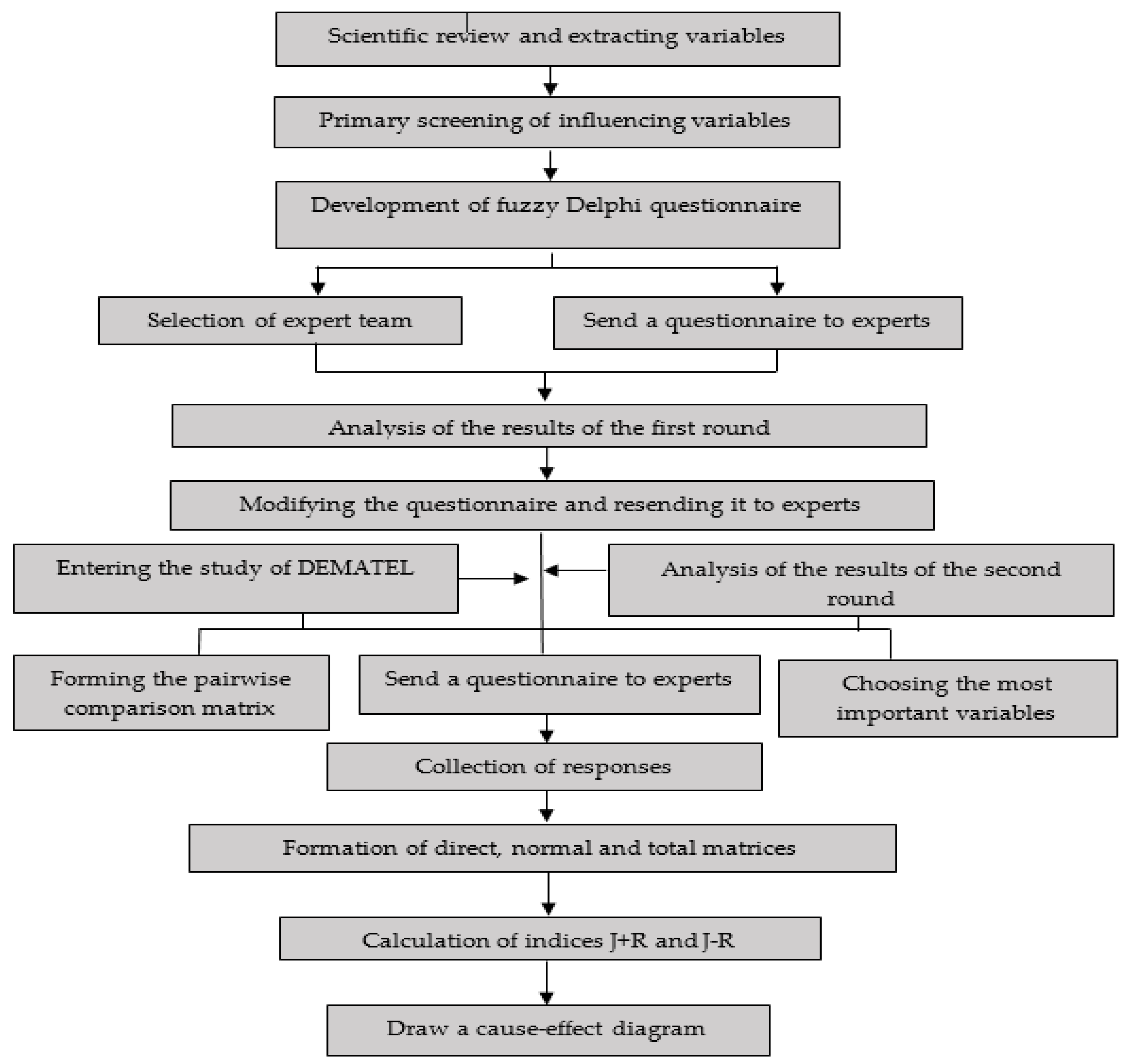

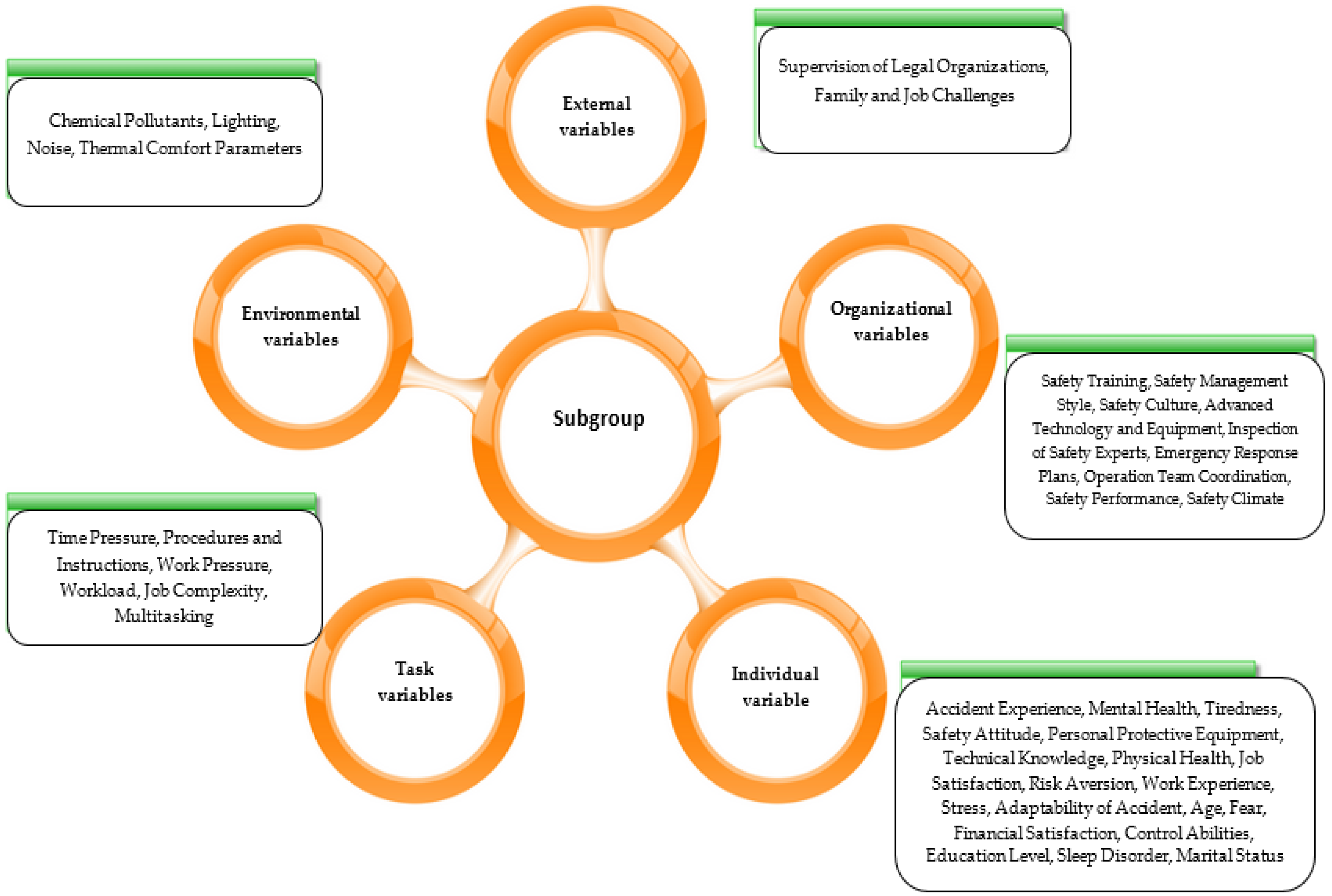
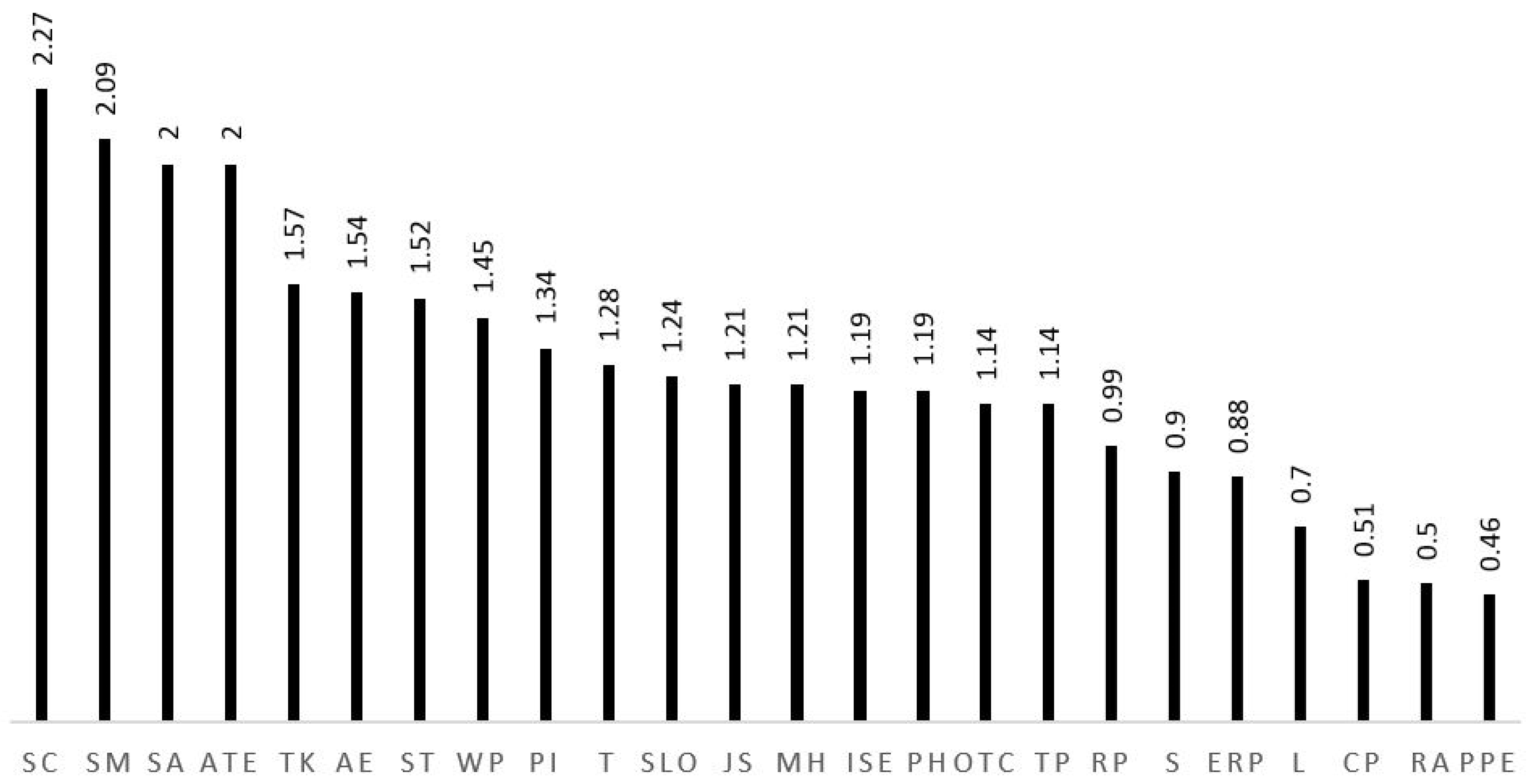


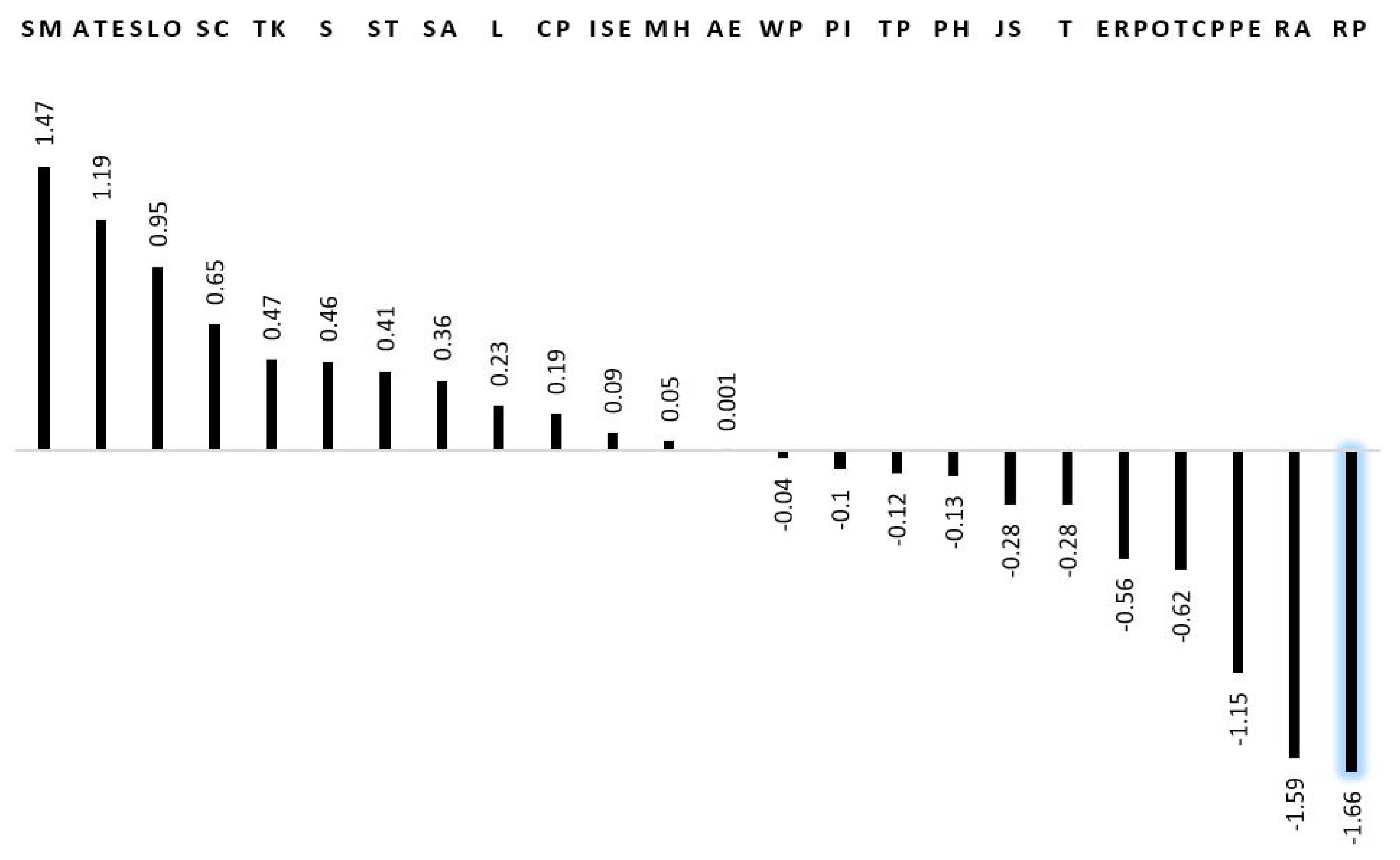
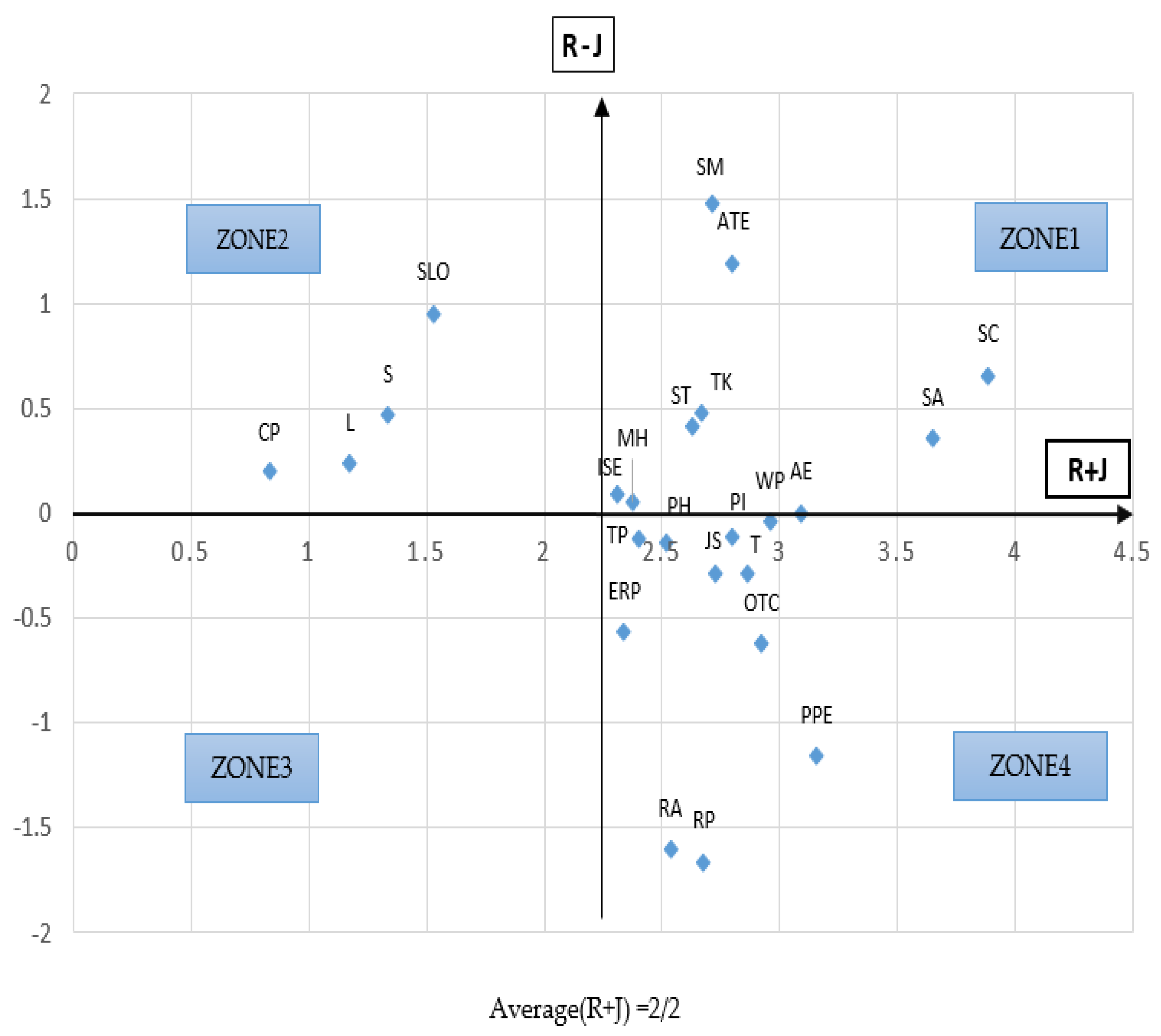
| Linguistic Expressions | Triangular Fuzzy Numbers |
|---|---|
| No effect | (1, 1, 2) |
| Extremely weak effect | (1, 2, 3) |
| Weak effect | (2, 3, 4) |
| Strong effect | (3, 4, 5) |
| Extremely strong effect | (4, 5, 5) |
| Sub-Group | Variable | Identification Code | De-Fuzzied Number |
|---|---|---|---|
| External variables | Supervision of legal organizations | SLO | 3.55 |
| Organizational variables | Safety training | ST | 4.52 |
| Safety management style | SM | 4.50 | |
| Safety culture | SC | 4.47 | |
| Advanced technology and equipment | ATE | 3.98 | |
| Inspection by safety experts | ISE | 3.93 | |
| Emergency response plans | ERP | 3.90 | |
| Operation team coordination | OTC | 3.89 | |
| Environmental variables | Chemical pollutants (methane gas, etc.) | CP | 3.94 |
| Lighting | L | 3.93 | |
| Noise | S | 3.55 | |
| Task variables | Time pressure | TP | 3.98 |
| Procedures and instructions | PI | 3.93 | |
| Work pressure | WP | 3.93 | |
| Individual variables | Accident experience | AE | 4.45 |
| Mental health | MH | 4.09 | |
| Tiredness | T | 4.07 | |
| Safety attitude | SA | 4.04 | |
| Personal protective equipment | PPE | 4.02 | |
| Technical knowledge | TK | 4.01 | |
| Physical health | PH | 3.96 | |
| Job satisfaction | JS | 3.90 | |
| Risk aversion | RA | 3.55 |
Disclaimer/Publisher’s Note: The statements, opinions and data contained in all publications are solely those of the individual author(s) and contributor(s) and not of MDPI and/or the editor(s). MDPI and/or the editor(s) disclaim responsibility for any injury to people or property resulting from any ideas, methods, instructions or products referred to in the content. |
© 2023 by the authors. Licensee MDPI, Basel, Switzerland. This article is an open access article distributed under the terms and conditions of the Creative Commons Attribution (CC BY) license (https://creativecommons.org/licenses/by/4.0/).
Share and Cite
Hannani, M.; Bascompta, M.; Sabzevar, M.G.; Dehghani, H.; Khajevandi, A.A. Causal Analysis of Safety Risk Perception of Iranian Coal Mining Workers Using Fuzzy Delphi and DEMATEL. Sustainability 2023, 15, 14277. https://doi.org/10.3390/su151914277
Hannani M, Bascompta M, Sabzevar MG, Dehghani H, Khajevandi AA. Causal Analysis of Safety Risk Perception of Iranian Coal Mining Workers Using Fuzzy Delphi and DEMATEL. Sustainability. 2023; 15(19):14277. https://doi.org/10.3390/su151914277
Chicago/Turabian StyleHannani, Mitra, Marc Bascompta, Mojtaba Gerami Sabzevar, Hesam Dehghani, and Ali Asghar Khajevandi. 2023. "Causal Analysis of Safety Risk Perception of Iranian Coal Mining Workers Using Fuzzy Delphi and DEMATEL" Sustainability 15, no. 19: 14277. https://doi.org/10.3390/su151914277
APA StyleHannani, M., Bascompta, M., Sabzevar, M. G., Dehghani, H., & Khajevandi, A. A. (2023). Causal Analysis of Safety Risk Perception of Iranian Coal Mining Workers Using Fuzzy Delphi and DEMATEL. Sustainability, 15(19), 14277. https://doi.org/10.3390/su151914277







